Do you feel weak and unsteady when you squat or do strong leg movements? If so, you’re not alone. Building strong, muscular legs is a constant struggle for many fitness enthusiasts.
Don’t despair!
Dumbbells are a fantastic tool for building serious leg strength and size. They’re easy to do, and you can do a lot of good leg exercises with them. They help you build quadriceps, hamstrings and calves.
I also loved using gym machines for leg workouts. When the lockdown hit, my leg routine disappeared. Out of necessity, I turned to dumbbells for my home workout.
The transformation was shocking. My legs became stronger and I became more athletic.
In this blog, you’ll find:
- Leg Anatomy
- Best dumbbell leg exercises
- How to execute them correctly.
- Workout Plans for All Levels… Many MORE.
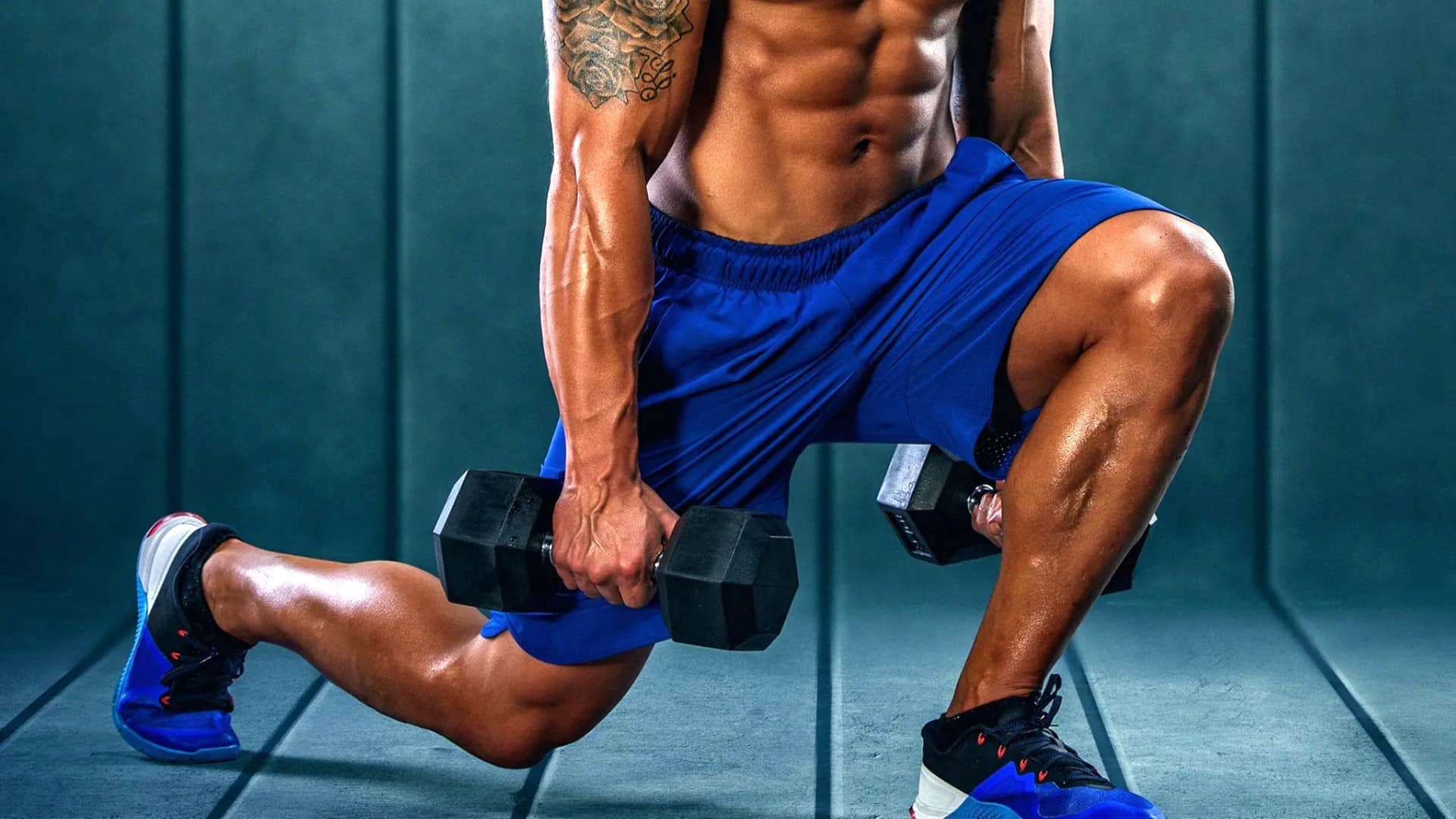
- Best Dumbbell Leg Exercises and Workout
- 1. Dumbbell Deadlift
- 2. Dumbbell Squat
- 3. Dumbbell Lunges
- 4. Dumbbell Sumo Squat
- 5. Dumbbell Step Up
- 6. Lying Dumbbell Leg Curl
- 7. Dumbbell Front Squat
- 8. Dumbbell Box Squat
- 9. Dumbbell Stiff-Leg Deadlift
- 10. Dumbbell Reverse Lunges
- 11. Dumbbell Swing
- 12. Dumbbell Bulgarian Split Squat
- 13. Dumbbell Jump Squat
- 14. Dumbbell Farmers Walk
- 15. One-leg Dumbbell Romanian Deadlifts
- 16. Dumbbell One Leg Hip Thrust
- 17. Dumbbell Goblet Squat
- 18. Standing Dumbbell Calf Raise
- 19. Standing Dumbbell One Leg Calf Raise
- 20. Seated Dumbbell One Leg Calf Raise
- Training Volume For Dumbbell Leg Workout
- Sets
- Reps
- Dumbbell Only Leg Workout Plan
- For Beginner
- Intermediate
- Dumbbell
- Know Your Leg Muscles (Anatomy
- 1. Quadriceps
- 2. Hamstrings
- 3. Gluteals
- 4. Calves
- FAQs
- Can I only use dumbbells for leg workouts?
- How often should I do a dumbbell leg workout?
- Can dumbbell leg exercises help me lose weight?
- How long should a dumbbell leg workout be?
- Can I do dumbbell leg exercises at home?
- Takeaways
Best Dumbbell Leg Exercises and Workout
Here are our top 20 dumbbell leg workouts to help you start off on the right foot and make your leg day much more interesting.
1. Dumbbell Deadlift
The Dumbbell deadlift exercise is the best variation of the classic barbell deadlift. This is one of the best dumbbell exercises to add mass in hamstring and other posterior chain muscles.
The deadlift exercise can be performed using either a barbell or a pair of dumbbells.
One of the biggest benefits of using dumbbells for deadlifts is that they increase the range of motion you can work in comparison to barbell deadlifts.
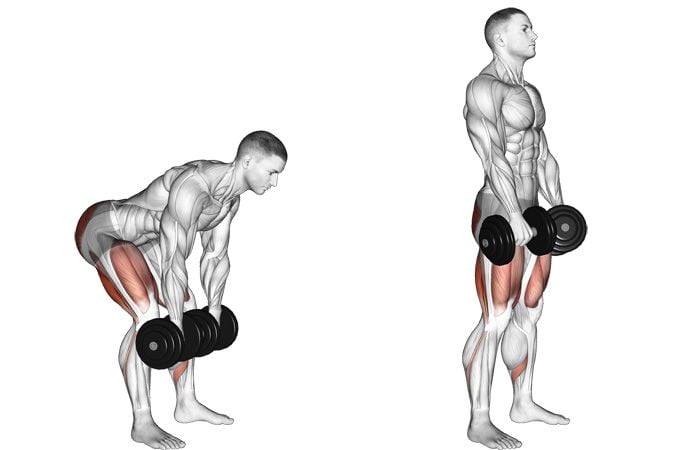
How To Do
- Place a dumbbell in front of you. Grab the Dumbbells with each of your hands.
- Raise the dumbbell from the ground using your hamstrings and glutes.
- You should keep your legs slightly bent, back straight, and head looking up.
- Raise it to the point where your body is erect.
- Hold the bar momentarily at the top of the lift and remember the lockout.
- Then, lower the dumbbells slowly at a steady, slow pace by bending at the hips and then at the knees.
Tips
- Do not go through half of the exercise; complete the lift.
- Remember to keep your back as straight as possible.
- If a deadlift is performed incorrectly, it can cause more harm than good.
- Avoid jerky movements and keep motion controlled.
2. Dumbbell Squat
Dumbbell Squats are an excellent alternative to barbell squats to build quality muscle mass in the legs. These leg exercises are done standing with a pair of dumbbells.
One benefit of the dumbbell squat over the barbell squat is that you can perform it anywhere without needing a spotter.
It is one of my favorite leg exercises that I use to train and build strong leg muscles.
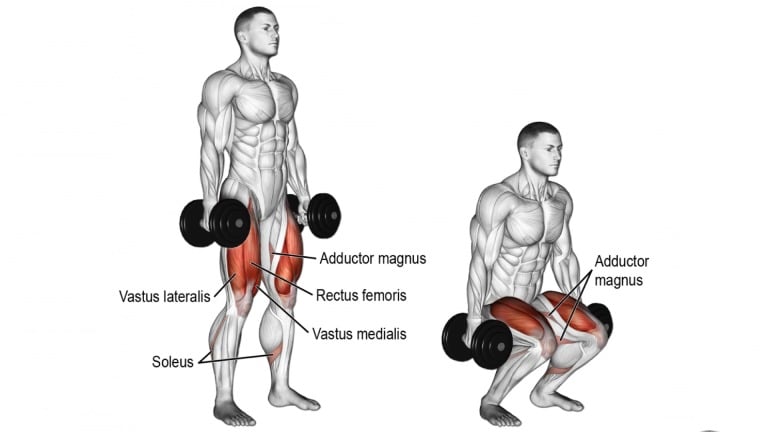
How To Do
- Grab hold of a pair of heavy dumbbells and stand upright with feet shoulder feet apart.
- Bend your knees and lower yourself with your back straight and head up until your thighs are parallel to the ground.
- Now raise yourself up using only the thigh power, keeping your back straight in a position with legs nearly locked out.
- Repeat for the desired number of repetitions.
Tips
- Keep your torso upright, shoulders back, head up, and feet flat.
- Exhale while moving up.
- Warm up well before the dumbbell leg workout.
Read More To Know More: 20 Best Quad Exercises To Build Mass & Strength
3. Dumbbell Lunges
Dumbbell lunges require good balance, so if you have issues keeping your balance, start by doing the lunges exercise without weights as you learn the proper form.
Be careful that the knee of the forward leg does not extend past the toes as you bend the leg. This can aggravate the knee joint if done too much and lead to an injury.
I usually do 12–15 reps on each side in a controlled manner to train my quad effectively. You should also try this with light weights.
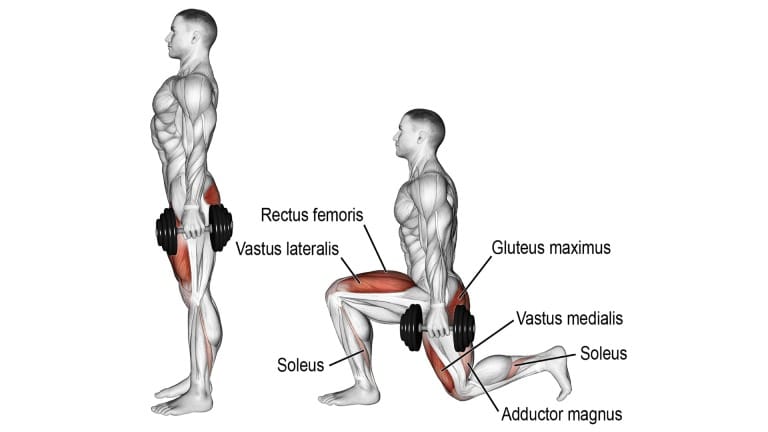
How To Do
- Hold a dumbbell in each hand, with your arms by your sides, and stand upright.
- Keeping your back straight, take a step forward, bending your knees and getting them as close to the floor as possible.
- Push yourself back to the starting position and repeat with the other foot.
- Keep alternating the leg with which you lunge.
Tips
- Bend as far and low as possible without losing form.
- Keep your torso upright and your head facing forward.
- If you have balance issues, it is best to use your own bodyweight while holding on to a steady object.
4. Dumbbell Sumo Squat
The dumbbell sumo squat is a popular leg workout using a single dumbbell held in front of the legs.
It is performed with a wider-than-shoulder-width stance, increasing the demand on the glutes, hamstrings, and adductors while benefiting the quads, core, and upper body.
The dumbbell sumo squat exercise is also easy on your lower back, which makes it suitable for people who suffer from lower back pain.
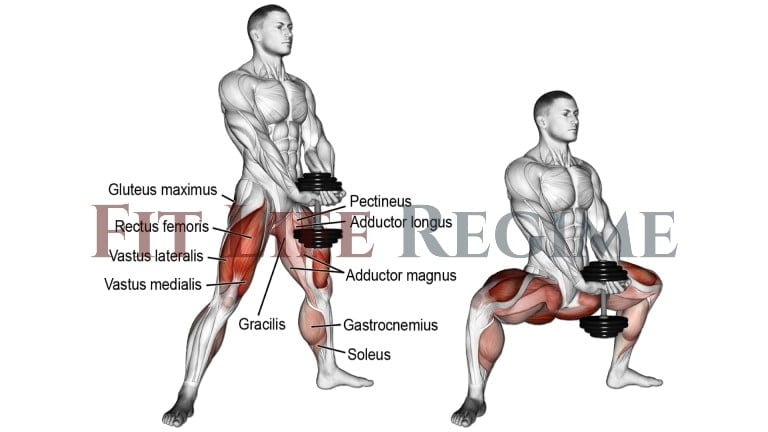
How To Do
- Grab a heavy dumbbell and hold one end with both hands.
- Stand with your feet slightly wider than hip-width apart and turn your feet out, externally rotating your hips.
- Take a deep breath in, then push your hips backward, lowering into a squat.
- Keep your core tight, back straight, and knees forward.
- Pause, then exhale and ensure you’re pushing through your heels and engaging your inner thighs as you return to your starting position.
Tips
- Do not allow the dumbbell to contact the floor.
- Stand on an elevated surface to allow room for the full range of motion if available.
- The lower back should have a natural arch with a chest out. Keep your abs tight throughout the exercise.
5. Dumbbell Step Up
The dumbbell step-up is a great leg workout for building lower-body strength and power.
This exercise targets the quadriceps and involves calves, glutes & hip flexors.
Whether you have just started exercising or have been training for years, the step-up is a great all-around exercise that can be modified to create a challenging workout for everyone.
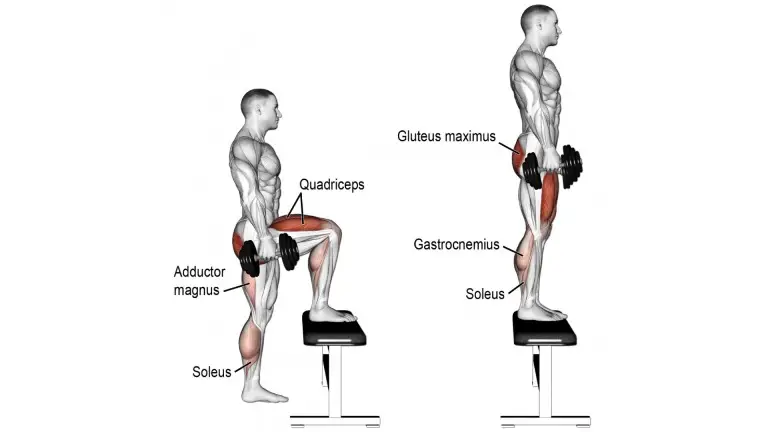
How To Do
- Place a knee-high box or bench in front of you and grasp a dumbbell in each hand, or use just your body weight.
- Stand with your feet in a comfortable hip-width stance.
- Step forward with one leg onto the step and drive through that thigh to bring your body upward.
- Bring the trailing leg to the top of the step and stand on the box, then step back with the opposite leg to the floor and lower yourself.
- Alternate legs with each rep. Repeat for the desired number of repetitions.
Tips
- Control the movement, using your muscles to lift and lower yourself slowly.
- Be sure to keep your low back in its natural arch and your upper body upright throughout the whole movement.
- Keep your body upright and your feet and knees pointing in the same direction.
6. Lying Dumbbell Leg Curl
The dumbbell leg curl is useful when you can’t access a leg curl machine. It is one of the best isolation exercises to build mass and strength in the hamstring muscles.
The hardest part of the dumbbell leg curl is learning how to hold the dumbbell between your feet.
The heavier the dumbbell becomes, the more difficult the exercise becomes. Therefore, start with a lightweight until you get used to it.
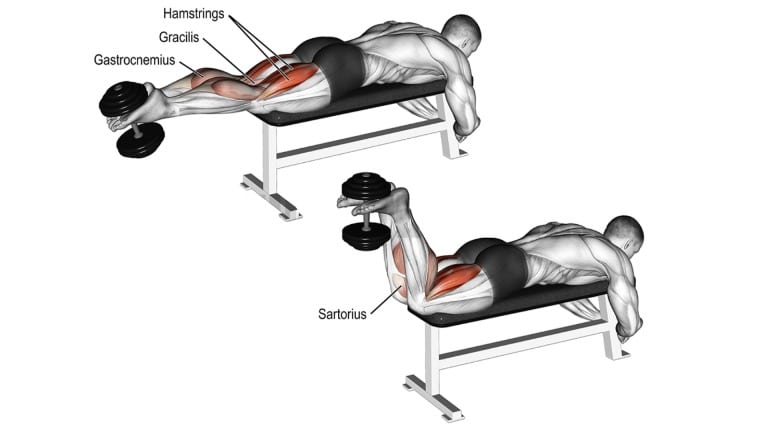
How To Do
- Place a dumbbell between your feet and lie down on a flat bench with your legs extended.
- Hold on to the pad’s edge or the bench’s legs for stability.
- Slowly bring the weight up by flexing your knees until your lower legs are just short of vertical.
- Slowly lower the dumbbell back to the starting position. Repeat for desired reps.
Tips
- Do not curl the dumbbell until you are confident it is securely held between your feet.
- Focus on moving the weight with your hamstrings, utilizing a full range of motion.
- Use a light dumbbell to get the form down before attempting heavier dumbbell leg curls.
Read More To Know More: 15 Best Hamstring Exercises For Mass And Strength
7. Dumbbell Front Squat
The squat and the dumbbell front squat work the same muscles. However, the dumbbell front squat recruits more stabilizer muscles, including various back muscles, shoulders, and your chest.
It is more advanced than the barbell squat, and the dumbbell front squat is the best option for leg workouts.

How To Do
- Hold a dumbbell in each hand with your palms facing toward your body.
- Stand with your feet shoulder-width apart and your toes pointing forward.
- Bring the dumbbells up to your shoulders, with your elbows pointing forward and your palms facing upwards.
- Keep your chest up and your back straight, and lower your body down into a squat position.
- Lower yourself down until your thighs are parallel to the ground.
- Pause briefly at the bottom of the squat, then push through your heels to return to the starting position.
Tips
- Start light and add weight gradually, allowing your legs and lower back time to adapt.
- Keep your core engaged, your chest up, and your back straight.
8. Dumbbell Box Squat
The dumbbell box squat is a compound leg exercise that uses a dumbbell and a plyometric box to work muscle groups throughout your body.
The posture of box squats puts slightly less pressure on your knee joints when compared to front squats or back squats.
This is a great exercise for learning how to squat because it reinforces the sitting-back portion of the squat.
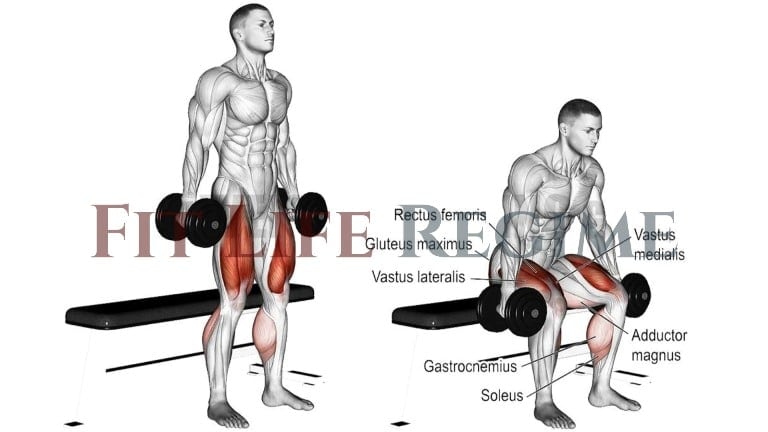
How To Do
- Place a box or bench that is about knee height behind you.
- Hold the dumbbells at your sides with your palms facing in towards your body.
- Squat back and down until your glutes contact the box, and immediately explode back up by pressing through your heels until you’re back in the standing position. Do not “plop” or fully sit down on the box.
- Repeat for the desired number of reps.
Tips
- As you stand, keep your chest high and squeeze your glutes
- You should use a box or bench that allows you to achieve proper depth without compromising form.
- Do not sit on the box and rock backwards, as this leads to compression of the spine; just pause and immediately raise.
9. Dumbbell Stiff-Leg Deadlift
If you are looking for a straightforward dumbbell leg exercise to build mass and strength in your hamstring, then the dumbbell stiff leg deadlift is a great staple exercise to get you started.
The dumbbell stiff-leg deadlift for hamstrings requires a lighter weight than that used during traditional powerlifting for strengthening the lower back.
I enjoy this exercise because I feel that my legs are completely trained after doing it.
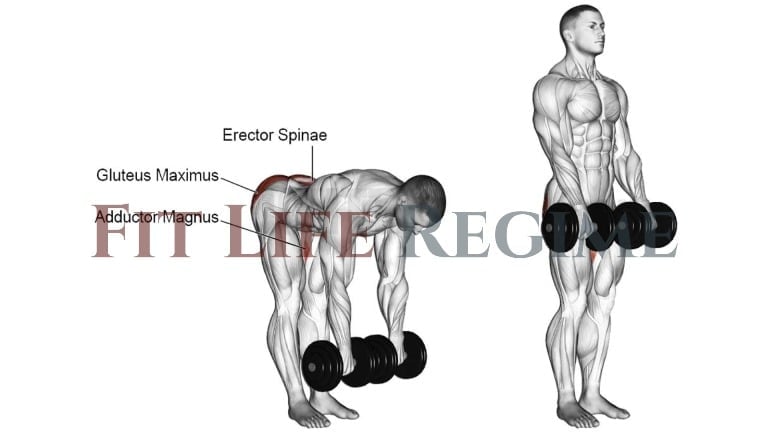
How To Do
- Grasp a dumbbell in each hand using a shoulder-width pronated (overhand) grip.
- Keeping your back straight, head up, and hips low, lift the dumbbell into a standing position.
- Flex your knees a little and push your hips backward and slowly lower the dumbbell down the front of your legs.
- Descend until you feel a mild stretch in your hamstrings.
- Exhale as you pull the dumbbell back up to the starting position by pushing your hips forward.
Tips
- Keep your knees stiff, your back and arms straight, and your head up.
- Do not allow the dumbbell to drift away from your body during the lift. Keep the dumbbell close to your body.
- Lower the weight until your hamstrings reach full stretch without rounding your spine.
10. Dumbbell Reverse Lunges
The dumbbell reverse lunge is great for developing balance, coordination, and unilateral lower-body strength.
It is an excellent leg exercise to build thigh muscles and glutes. Along with squats, lunges are highly recommended to build your butt muscles.
- A small lunge places emphasis on your quadriceps,
- Whereas, a large lunge places emphasis on your gluteus maximus.
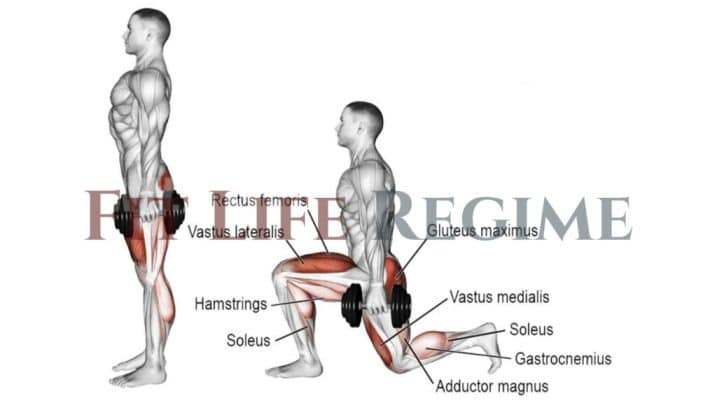
How To Do
- Hold a dumbbell in each hand, with your arms by your sides, and stand upright.
- Keeping your torso upright, inhale as you take a large step backward with one leg and plant your forefoot behind you.
- As you do so, flex the knee and hip of your front leg to allow yourself to descend into a kneeling position.
- Exhale as you get back up into the starting position by extending the knee and hip of your front leg and pushing off with your rear leg.
- Repeat the movement with your opposite leg.
- Keep alternating the leg with which you lunge backward.
Tips
- Keep your feet and knees pointing in the same direction.
- Keep your torso upright and your head facing forward.
- Be careful that the knee of the forward leg does not extend past the toes as you bend the leg.
- Do not allow your rear knee to contact the floor.
11. Dumbbell Swing
If you’re looking for one more effective leg workouts for mass and strength, try the dumbbell swing.
Kettlebell swings are based on the deadlift movement pattern and hit almost every muscle in the body, especially those of the posterior chain, resulting in a stronger back and hips.
The kettlebell swing can be used in cardio circuits and to strengthen your posterior chain muscles.
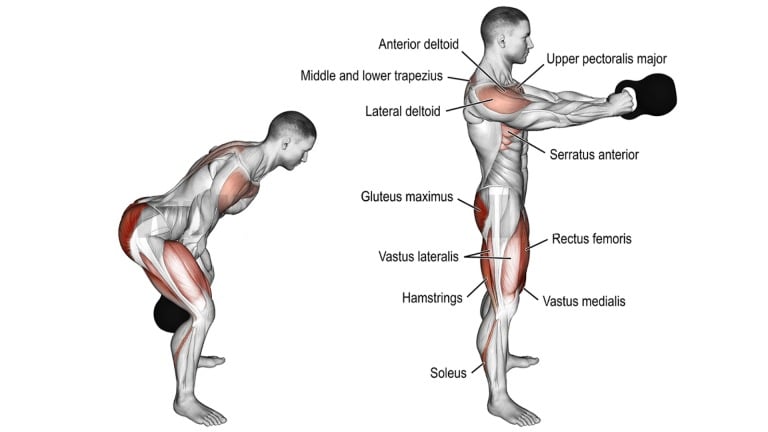
How To Do
- Place your feet slightly wider than shoulder-width apart.
- Your arms in front of your body and use both hands, palms down, to hold the dumbbell
- With your knees bent slightly and hips thrust back, adopt a squat like position, but refrain from going as far down.
- Drive your hips forward while swinging the kettlebell forward and up to shoulder height.
- The dumbbell should then be lowered back between your legs and the swinging motion repeated for 12–15 repetitions.
Tips
- Keep your head up, your core tight, your back straight, and your feet flat.
- Do not swing the kettlebell too high, stop when your arms parallel the floor.
12. Dumbbell Bulgarian Split Squat
The dumbbell Bulgarian split squat is also known as the single-leg dumbbell split squat and the back-foot-elevated split squat.
It is an effective auxiliary exercise for improving your squat and lunge. It is also great for enhancing your balance and developing unilateral functional strength.
To promote equal contralateral strength (equal strength in both sides), start with your weak leg, and do not do more repetitions with your strong leg.
I usually use a weighted Bulgarian split squat to train the quad muscles during my leg workout.
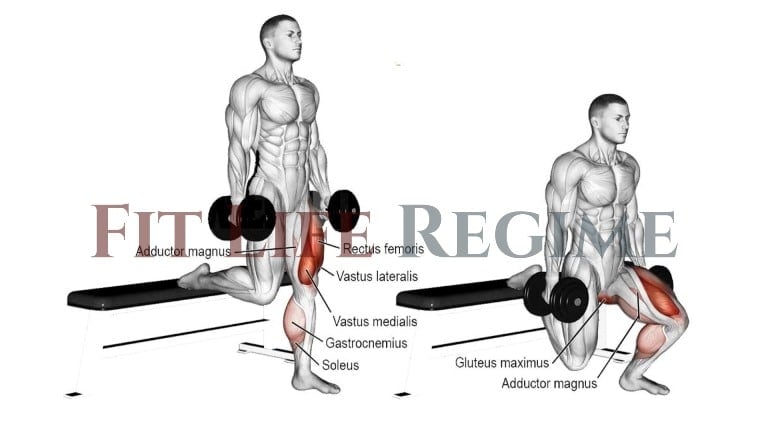
How To Do
- Hold a dumbbell in each hand, with your arms by your sides.
- Stand with your back facing the side of a bench. There should be three or four feet of space between you and the bench.
- Extend one leg backward and place the top of your foot on the bench so that your body is being supported by only one leg.
- Keep your torso upright and inhale as you squat down with your supporting leg.
- Exhale as you push yourself back up to the starting position, driving through your heel.
- Repeat for the prescribed number of repetitions. Repeat the exercise with your opposite leg.
Tips
- When you squat, your front knee should not pass your toes.
- Keep your torso upright and your head facing forward.
- If you have balance problems, it’s best to avoid them or use your own bodyweight.
13. Dumbbell Jump Squat
Dumbbell Jump squats also known as squat jumps are the power packed HIIT version of squats.
Dumbbell Squat jumps and their variations help shed fat from the body, tone your butt and legs, and improve strength and balance.
Squat jumps are a great dumbbell exercise to include in-home Leg workouts, since they can be done in a small space without any equipment.
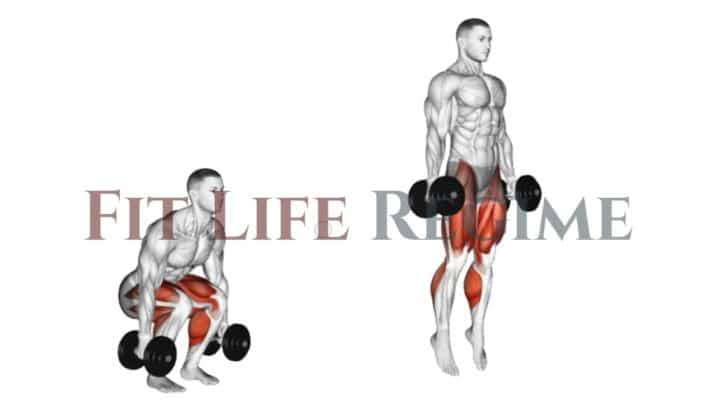
How To Do
- Stand with your feet about shoulder-width apart and your knees slightly bent.
- Quickly drop by bending at the knees and hips, letting your glutes track backward to lower yourself into a squat.
- At the point where your thighs are parallel to the floor, quickly and explosively reverse direction, driving up through your heels and the balls of your feet to lift your body off the floor as high as possible.
- Land with soft knees and immediately lower into the next rep.
Tips
- Keep your head up and your torso upright.
- Don’t perform this exercise with cold muscles. Do a cardio warm-up before it.
14. Dumbbell Farmers Walk
The dumbbell farmer’s walk is a great exercise for improving your overall strength and functional fitness by strengthening your core, back, glutes, legs, and gait.
The farmer’s walk exercise also called the farmer’s carry, is a strength and conditioning exercise in which you hold a heavy load in each hand while walking for a designated distance.

How To Do
- Reach down, bending at the hips and knees, and grasp the dumbbells in each hand.
- Hold the dumbbells at your side with a firm grip.
- Stand tall, keeping your shoulders, back, and core tight.
- Take small steps and walk forward at an even pace with your eyes focused straight ahead of you.
- Complete the desired number of steps, come to a stop, and place the dumbbells down.
Tips
- Focus on squeezing your shoulder blades and tightening your abs.
- Keep a neutral or straight spine throughout the movement to avoid injury.
15. One-leg Dumbbell Romanian Deadlifts
The single leg Dumbbell RDL is a unilateral movement, so it is going to help increase the demand on your core and hips demand through anti-rotation.
Overall, it’s a great exercise for increasing hamstring and glute health, reinforcing proper hamstring engagement during deadlifts, improving joint function at the hips, and enhancing bilateral strength and performance.
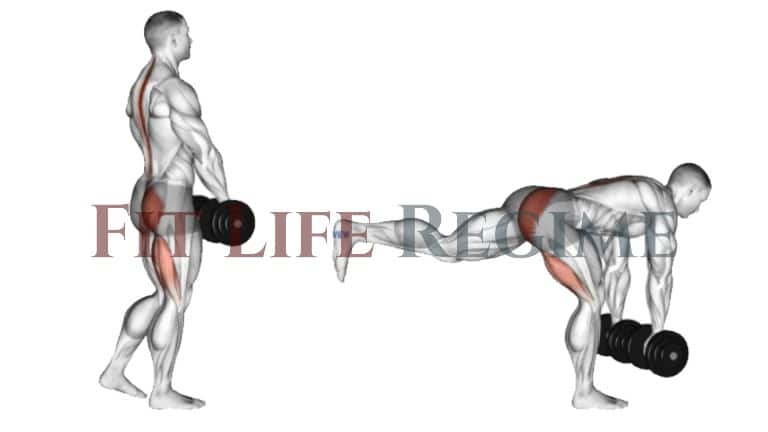
How To Do
- Stand with your feet shoulder-width apart, knees slightly bent, and raise one leg off the floor.
- Flex the knee on your standing leg about 15-20% to activate the glutes.
- Keep your back naturally arched, bend (hinge) at your hips, and lower your torso until it’s almost parallel to the floor.
- Briefly pause at the bottom, then squeeze your glutes and thrust your hips forward.
- Then, raise your torso back to the starting position.
Tips
- Make sure your back stays neutral throughout the movement.
- Keep soft knees and ensure the movement occurs primarily at your hips.
16. Dumbbell One Leg Hip Thrust
The dumbbell hip thrust is a popular exercise that works the glutes and hamstrings and builds muscle and strength.
Now, a lot of people are afraid to perform this movement or just not interested since it requires a little setup and may even look a little funny.
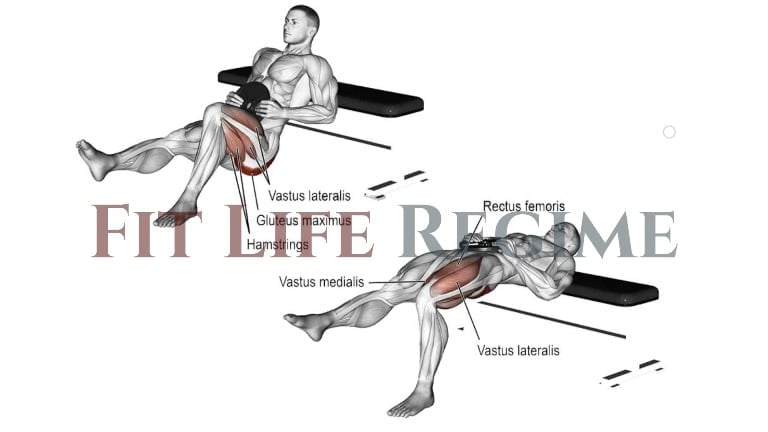
How To Do
- Holding a weight with both hands, sit on the side of a bench, and rest the weight plate on your abdomen.
- Slide your buttocks off the side of the bench and rest your back against its edge.
- Raise one leg off the floor. Keep your body straight and put both hands on the weight plate.
- As you lift the weight plate, exhale as you extend the hip of your supporting leg.
- Hold for a count of two and squeeze your glute.
- Inhale as you lower the weight plate to the starting position by flexing the hip of your supporting leg.
- Repeat for the prescribed number of repetitions.
Tips
- To prevent the bench from tipping over, place it against a wall.
- Do not allow your back to arch or your pelvis to tilt. Keep your torso rigid.
- Keep your torso rigid. Your back shouldn’t arch, and your pelvis shouldn’t tilt.
- All the movement should occur in your hips.
17. Dumbbell Goblet Squat
The dumbbell goblet squat is a variation of the squat and an exercise used to build the muscles of the legs. In particular, the dumbbell goblet squat will place a lot of emphasis on the quads.
This dumbbell compound leg workout will help you build serious leg and glute strength.
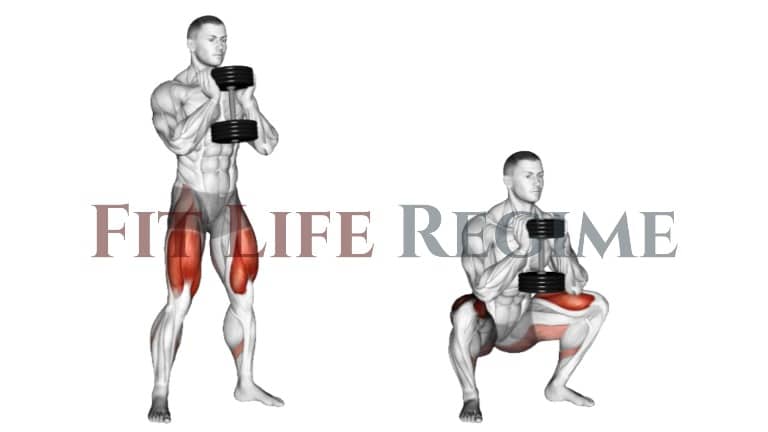
How To Do
- Select a dumbbell and position it at chest height with one hand under each edge of the dumbbell.
- Take a deep breath and descend by simultaneously pushing the hips back and bending the knees.
- Once your thighs reach parallel with the floor, begin to reverse the movement.
- Keep your abs braced and drive your feet through the floor.
- Drive back to the starting position.
Tips
- Experiment with a “false” (i.e. thumbless) grip, as this helps to eliminate elbow and wrist issues in some folks.
- As you stand, keep your chest high and squeeze your glutes
18. Standing Dumbbell Calf Raise
This exercise can be performed anywhere with a dumbbell only, and it is also possible to perform the exercise without a machine. The calf raise is an exercise that can be found in many training plans.
To work your calve muscles harder than a bodyweight standing calf raise; you can add resistance to the move.
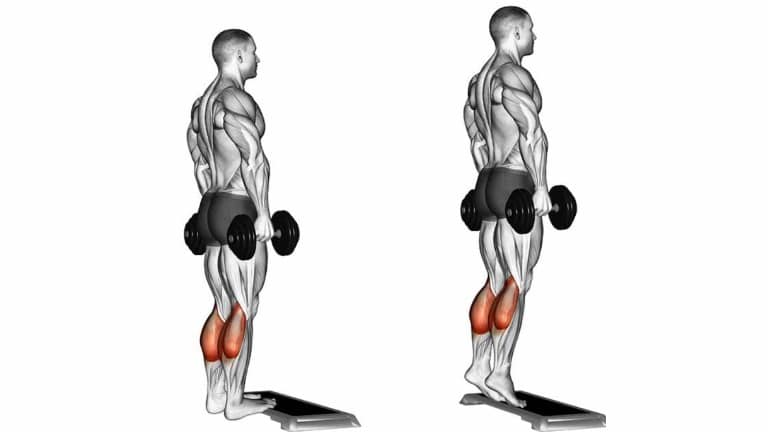
How To Do
- Hold a weight in each hand. Stand up straight on the stepper with your feet facing forward and placed hip-width apart.
- Keep a slight bend in your knee and hold your hands by your side.
- Raise your heels by pressing the balls of your feet into the ground.
- You should move your body upwards until you’re standing on your toes.
- Hold this position, and then slowly lower your heels back to the ground.
Tips
- Pause and squeeze for a count of 1-2 at the movement’s top for added intensity.
- Keep the balls of your feet on the edge of the block/step. If you allow the balls of your feet to come in more, the exercise becomes easier
Read More: 12 Most Effective Smith Machine Leg Workout & Exercises
19. Standing Dumbbell One Leg Calf Raise
Single-leg calf raises are one of the best ways to build your calf muscles.
Standing dumbbell calf raise is a very effective isolation exercise that targets the Gastrocnemius and Soleus muscles.
You can do the standing dumbbell one-leg calf raise on the floor if you don’t have a platform to perform the exercise.
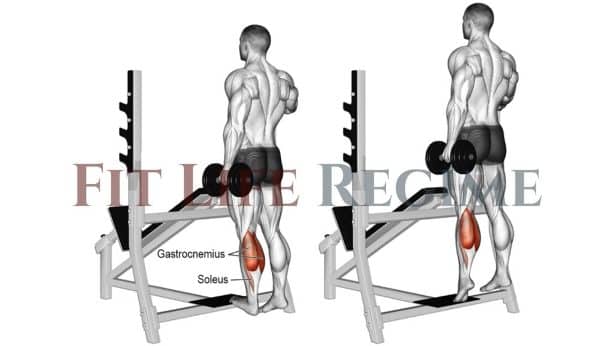
How To Do
- Hold a dumbbell by your side in your left hand. With your left foot, stand on a platform, with the arch and heel of your foot suspending off.
- Grasp something with your right hand for stability. Exhale as you raise your heel by extending your ankle.
- Hold for a count. Inhale as you slowly reverse the motion and lower your heel until you feel a mild stretch in your calf.
- Hold for a count of one. Repeat for more repetitions. Repeat with your right leg.
Tips
- Keep the movement slow and under control.
- Do not lock out your knee.
20. Seated Dumbbell One Leg Calf Raise
The seated dumbbell one-leg calf raise places more stress on the soleus than it does on the gastrocnemius.
It may also be performed with both legs simultaneously, but doing it one leg at a time is recommended to execute it as properly and safely as possible.
It can be used as an alternative to the machine seated one-leg calf raise if you do not have access to the seated calf raise machine.
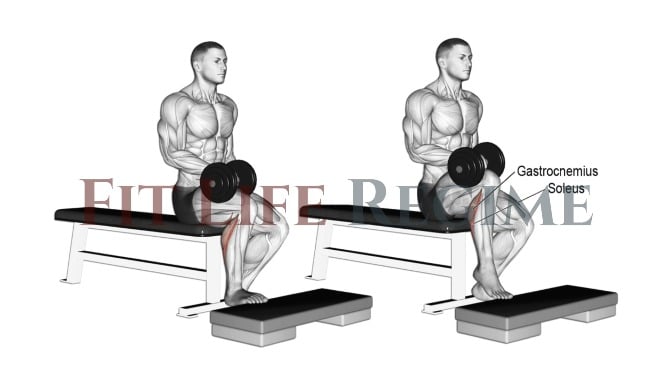
How To Do
- Sit with the front of your right foot placed on top of a block or step in front of you.
- Hips and knees should be bent at a ninety-degree angle.
- Dip the heel of your right foot as low as it can go.
- Hold a dumbbell vertically on top of your right knee.
- Exhale as you lift your right heel as high as possible, pushing against the dumbbell’s weight.
- Keep your right heel lifted for 2 counts. Slowly lower it as you inhale.
- Repeat the exercise on your left foot.
Tips
- Move slowly as you stretch your calf muscle.
- Make sure you hold the stretch for a second at the top, returning to the starting position.
- Engage your core to keep your torso upright throughout the exercise.
Training Volume For Dumbbell Leg Workout
However, your leg training frequency also depends on your workout split. Of course, the number of sets and reps will be determined based on your fitness journey, but here is a great starting point:
Sets
- Beginners (with a year or less of training) should aim for about 12 weekly sets.
- An Intermediate trainee (with two to four years of training) can increase the volume to 16 sets per week.
- An advanced trainee (four or more years of training) may be able to get in up to 20 weekly sets.
When a certain amount of volume stops being effective and your progress stalls, you can add sets to increase volume and use that as a driver of renewed progress.
Reps
The best rep ranges and loads to work with.
- 6–8 reps with a heavy load
- 8–15 reps with moderate load
- 15-20+ with a light load
The load should bring you to or near failure within the given rep ranges for the exercise to be effective. Find the workout that suits your experience level and goals. You’ll need to use a range of equipment (dumbbell, cable, bodyweight) and techniques if you want to train the muscle group effectively.
Dumbbell Only Leg Workout Plan
Please note that these are just examples, and it’s important to customize a workout plan to fit your individual needs, abilities, and goals.
For Beginner
| Exercise | Sets x Reps | Rest |
| Dumbbell Squats | 3 x 8 | 60-90 seconds |
| Dumbbell Lunges | 3 x 10 | 60-90 seconds |
| Dumbbell Step-ups | 3 x 10 | 60-90 seconds |
| Dumbbell Calf Raises | 3 x 15 | 60-90 seconds |
Intermediate
| Exercise | Sets x Reps | Rest |
| Dumbbell Sumo Squat | 3 x 8 | 45-60 seconds |
| Dumbbell Step Up | 3 x 10 | 45-60 seconds |
| Dumbbell Stiff-Leg Deadlift | 3 x 10 | 45-60 seconds |
| Dumbbell Swing | 3 x 8 | 45-60 seconds |
| Dumbbell Calf Raise | 3 x 8 | 45-60 seconds |
Dumbbell
| Exercise | Sets x Reps | Rest |
| Dumbbell Goblet Squat | 4 x 8 | 45-60 seconds |
| Dumbbell Reverse Lunge | 4 x 8 | 45-60 seconds |
| Dumbbell Hip Thrust | 4 x 8 | 45-60 seconds |
| Dumbbell One Leg Calf Raise | 4 x 10 | 45-60 seconds |
| Dumbbell Romanian Deadlifts | 4 x 12 | 45-60 seconds |
In all three examples, the rest periods between sets gradually decrease from 60 seconds for beginners to 45 seconds for advanced individuals. Choosing challenging weights that still allow for proper form and technique is important.
Know Your Leg Muscles (Anatomy
The leg is divided into the upper leg (thigh) and lower leg (calf).
The upper leg consists of one bone, the femur, whereas the lower leg consists of two bones, the tibia (located on the big-toe side) and fibula (on the little toe side).
The legs consist of dozens of muscles that flex, bend, extend, adduct, abduct, and rotate your legs and allow movement.
This ultimate barbell leg workout focuses on four main muscle groups — the quadriceps, hamstrings, glutes, and calves.

1. Quadriceps
The quadriceps femoris, located in front of the thigh, has four separate heads:
- Vastus medialis
- Rectus femoris
- Vastus lateralis
- Vastus intermedius
2. Hamstrings
The hamstrings, located behind the thigh, are a group of three muscles that originate from the ischium bone of the pelvis:
- Biceps femoris
- Semimembranosus
- Semitendinosus
3. Gluteals
The gluteus maximus arises from a large area on the rear of the pelvic bone, passes down behind the hip joint, and attaches to the upper femur. This powerful muscle causes hip extension.
4. Calves
The calf comprises two muscles:
- The gastrocnemius
- Soleus.
Other thigh muscles include the following: Hip adductors (Inner thigh), hip abductors, hip flexors.
FAQs
Can I only use dumbbells for leg workouts?
Yes, you can create an effective leg workout routine using various dumbbell exercises if you only have access to dumbbells.
How often should I do a dumbbell leg workout?
Ideally, training each muscle group at least once per week is recommended.
However, you can do a dumbbell leg workout up to 2-3 times per week if you want to see faster results or address specific muscle imbalances.
Can dumbbell leg exercises help me lose weight?
Yes, leg exercises help you burn many calories since they target some of the largest muscles in the body. You can boost your metabolism and lose weight by incorporating dumbbell leg exercises into your workout routine.
How long should a dumbbell leg workout be?
A beginner leg workout may take between 30 and 45 minutes, while an advanced one could take up to an hour.
It’s important to focus on quality over quantity and prioritize proper form and technique.
Can I do dumbbell leg exercises at home?
Yes, you can do dumbbell leg exercises at home with a set of dumbbells and a small workout space.
Takeaways
Dumbbells are an excellent choice for leg training due to their versatility, safety, and ease of use.
Incorporating these exercises into your leg workout routine can strengthen imbalances and add volume for better muscle growth.
Even if you only use dumbbells to exercise your legs, it can make them stronger and bigger and also help you burn calories.
Did these exercises make a difference in your leg development? Share your results and experiences in the comments below.

Manish brings over 10 years of hands-on experience in weight lifting and fat loss to fitness coaching. He specializes in gym-based training and has a lot of knowledge about exercise, lifting technique, biomechanics, and more.
Through “Fit Life Regime,” he generously shares the insights he’s gained over a decade in the field. His goal is to equip others with the knowledge to start their own fitness journey.
